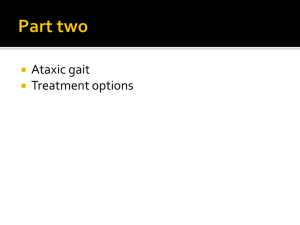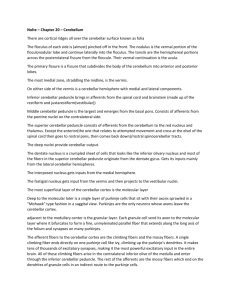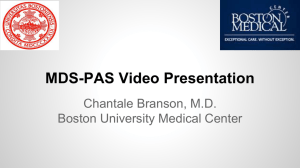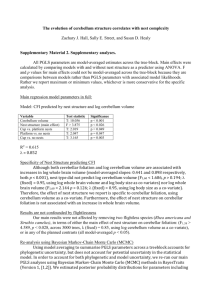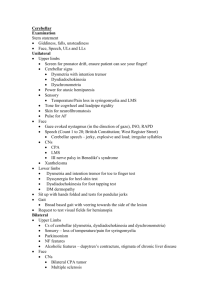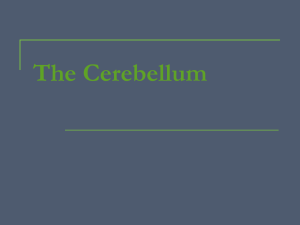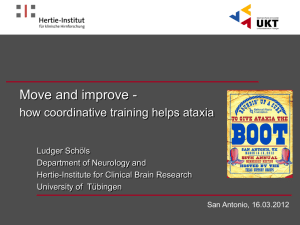Neuroanatomy Ch 15 698-720 [4-20
advertisement
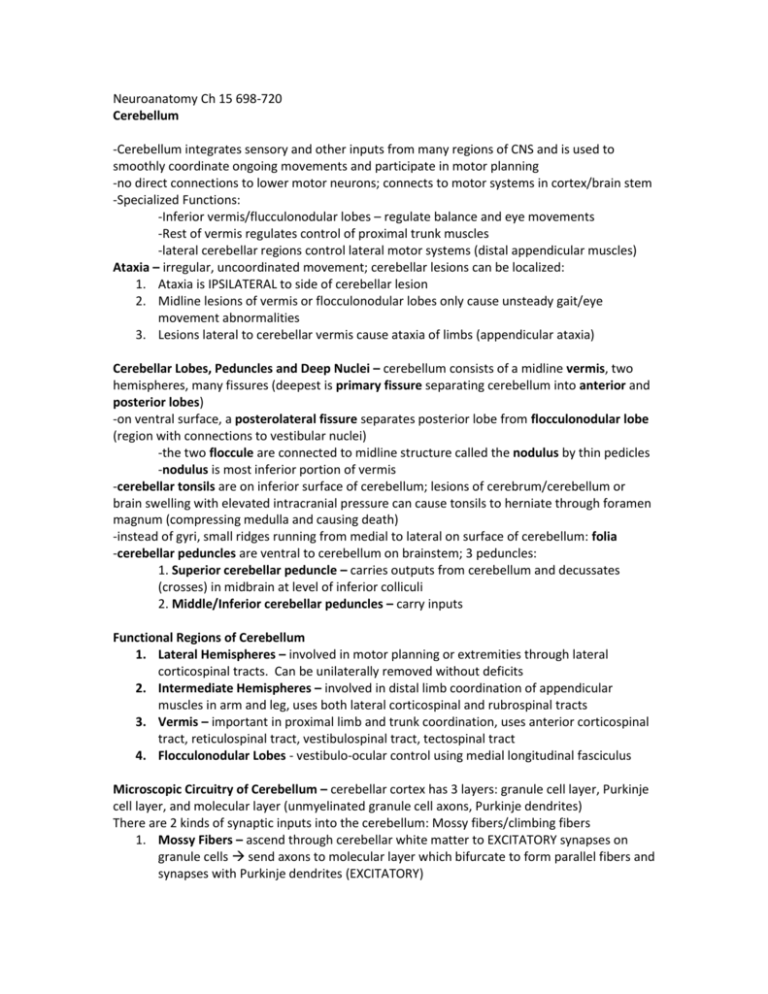
Neuroanatomy Ch 15 698-720 Cerebellum -Cerebellum integrates sensory and other inputs from many regions of CNS and is used to smoothly coordinate ongoing movements and participate in motor planning -no direct connections to lower motor neurons; connects to motor systems in cortex/brain stem -Specialized Functions: -Inferior vermis/flucculonodular lobes – regulate balance and eye movements -Rest of vermis regulates control of proximal trunk muscles -lateral cerebellar regions control lateral motor systems (distal appendicular muscles) Ataxia – irregular, uncoordinated movement; cerebellar lesions can be localized: 1. Ataxia is IPSILATERAL to side of cerebellar lesion 2. Midline lesions of vermis or flocculonodular lobes only cause unsteady gait/eye movement abnormalities 3. Lesions lateral to cerebellar vermis cause ataxia of limbs (appendicular ataxia) Cerebellar Lobes, Peduncles and Deep Nuclei – cerebellum consists of a midline vermis, two hemispheres, many fissures (deepest is primary fissure separating cerebellum into anterior and posterior lobes) -on ventral surface, a posterolateral fissure separates posterior lobe from flocculonodular lobe (region with connections to vestibular nuclei) -the two floccule are connected to midline structure called the nodulus by thin pedicles -nodulus is most inferior portion of vermis -cerebellar tonsils are on inferior surface of cerebellum; lesions of cerebrum/cerebellum or brain swelling with elevated intracranial pressure can cause tonsils to herniate through foramen magnum (compressing medulla and causing death) -instead of gyri, small ridges running from medial to lateral on surface of cerebellum: folia -cerebellar peduncles are ventral to cerebellum on brainstem; 3 peduncles: 1. Superior cerebellar peduncle – carries outputs from cerebellum and decussates (crosses) in midbrain at level of inferior colliculi 2. Middle/Inferior cerebellar peduncles – carry inputs Functional Regions of Cerebellum 1. Lateral Hemispheres – involved in motor planning or extremities through lateral corticospinal tracts. Can be unilaterally removed without deficits 2. Intermediate Hemispheres – involved in distal limb coordination of appendicular muscles in arm and leg, uses both lateral corticospinal and rubrospinal tracts 3. Vermis – important in proximal limb and trunk coordination, uses anterior corticospinal tract, reticulospinal tract, vestibulospinal tract, tectospinal tract 4. Flocculonodular Lobes - vestibulo-ocular control using medial longitudinal fasciculus Microscopic Circuitry of Cerebellum – cerebellar cortex has 3 layers: granule cell layer, Purkinje cell layer, and molecular layer (unmyelinated granule cell axons, Purkinje dendrites) There are 2 kinds of synaptic inputs into the cerebellum: Mossy fibers/climbing fibers 1. Mossy Fibers – ascend through cerebellar white matter to EXCITATORY synapses on granule cells send axons to molecular layer which bifurcate to form parallel fibers and synapses with Purkinje dendrites (EXCITATORY) a. All output from cerebellar cortex is carried by axons of Purkinje cells into cerebellar white matter i. Purkinje cells form inhibitory synapses onto deep cerebellar nuclei and vestibular nuclei, which convey outputs from cerebellum to other regions though excitatory synapses 2. Climbing Fibers – arise from contralateral inferior olivary nucleus and wrap around Purkinje cells to form excitatory synapses. Climbing fibers have strong modulatory effect on Purkinje cells to decrease their response to inputs from parallel fibers * Not as Imporant Cells: Basket Cells and Stellate cells – found in the molecular layer and are excited bysynaptic inputs from granule cell parallel fibers; both are INHIBITORY on Purkinje cells Golgi cells are found in granule cell layer and provide feedback inhibition to granule cells SUMMARYMossy fibers EXCITE granule cells EXCITE the inhibitory Purkinje cells Climbing fibers EXCITE Purkinje cells directly Purkinje dendrites extend to parallel fibers (made by granule cells) -all axons pointing UP toward cerebellar cortex are excitatory (climbing fibers, mossy fibers, granule cell parallel fibers), all axons pointing DOWN are inhibitory (Purkinje cells, stellate cells, basket cells, and golgi cells) -outputs of deep cerebellar nuclei are EXCITATORY Cerebellar Output Pathways – lesions of lateral cerebellum affects distal limb coordination -lesions of medial cerebellum affect trunk control, posture, balance, and gait -deficits in coordination occur IPSILATERAL to the lesion because most pathways are DOUBLE CROSSED (crossed twice) to lead to ipsilateral symptoms Main Cerebellar Output Pathways: 1. Lateral Hemispheres – travel to ventrolateral nucleus of thalamus (VL) and parvocellular red nucleus a. Involved in motor planning in corticospinal systems 2. Intermediate Hemispheres – Travel to VL and magnocellular red nucleus a. Involved in control of ongoing movements of distal extremities 3. Vermis – Travel to VL, tectum, reticular formation, and vestibular nuclei 4. Inferior Vermis and Flocculonodular Lobe – Travel to medial longitudinal fasciculus (eye movement pathways) a. Involved in proximal trunk movements and vestibulo-ocular control, respectively Cerebellar Input Pathways – cerebellar inputs have a somatotopic organization, with ipsilateral body represented in both anterior and posterior lobes -outermost layer is leg, followed by arm more medially, followed by head even more medially, and in the dead center you have information from auditory and visual cortex -most inputs are carried by mossy fibers, except those carried by climbing fibers Main Cerebellar Input Pathways 1. Pontocerebellar Fibers – origin is from Cortex, carry information from frontal, temporal, parietal, and occipital lobes 2. Spinocerebellar Pathways a. Dorsal Spinocerebellar Tract – from leg proprioceptors (touch and pressure sensation) b. Cuneocerebellar Tract – from arm proprioceptors c. Ventral Spinocerebellar Tract – from leg interneurons d. Rostral Spinocerebellar Tract – from arm interneurons -spinocerebellar pathways provide feedback information of two different kinds to cerebellum: -Afferent information about limb movements through dorsal spinocerebellar tract for lower extremity and cuneocerebellar tract for upper extremity and neck -Information about activity of spinal cord interneurons, thought to reflect amount of activity in descending pathways carried by ventral spinocerebellar tract for lower extremity and rostral spinocerebellar tract for upper extremity 3. Climbing Fibers – from red nucleus, cortex, brainstem, spinal cord 4. Vestibular Inputs – from vestibular system, controls balance and equilibrium as well as vestibulo-ocular reflexes Vascular Supply to the Cerebellum- 3 branches of vertebral and basilar arteries: 1. Posterior Inferior Cerebellar Artery (PICA) – supplies lateral medulla, inferior half of cerebellum, and inferior vermis 2. Anterior Inferior Cerebellar Artery (AICA) – supplies inferior lateral pons, middle cerebellar peduncle, and strip of ventral cerebellum between PICA and SCA, including flocculus 3. Superior Cerebellar Artery (SCA) – supplies upper lateral pons, superior cerebellar peduncle, superior cerebellar hemisphere, deep cerebellar nuclei and superior vermis Cerebellar Artery Infarcts – infarcts are more common in PICA and SCA than in AICA -Symptoms are vertigo, nausea, vomiting, horizontal nystagmus, limb ataxia, unsteady gait, and headache -many symptoms result from infarcts to lateral medulla or pons and not cerebellum itself: trigeminal/spinothalamic sensory loss and Horner’s syndrome -AICA Infarcts – unilateral hearing loss, can affect both brainstem and cerebellum -SCA Infarcts – spare lateral brainstem and involve cerebellum, cause unilateral ataxia without brainstem signs, can cause swelling of cerebellum (hydrocephalus due to 4th ventricle compress) -PICA Infarcts – can cause vertigo, swelling of cerebellum (hydrocephalus due to 4th ventricle compress) -if PICA or SCA cause compression of posterior fossa, respiratory centers could be compromised Cerebellar Hemorrhage – can be caused by chronic hypertension, arteriovenous malformation, hemorrhagic conversion of ischemic infarct, metastasis, or more -Symptoms: headache, nausea, vomiting, ataxia, nystagmus; if large, can obstruct 4th ventricle and cause hydrocephalus and CN VI palsies and impaired consciousness/death -sometimes presents only with nausea and vomiting, termed fatal gastroenteritis -Treatment: hydrocephalus can be treated with ventriculostomy; surgical evacuation of hemorrhage and decompression of posterior fossa are necessary Clinical Findings and Localization of Cerebellar Lesions – Ataxia literally means lack of order, referring to disordered contractions of agonist and antagonist muscles and the lack of normal coordination between movements at different joints Truncal Ataxia – caused by lesion confined to cerebellar vermis; patients have wide-based, unsteady, drunk-like gait. (severe truncal ataxia causes problems in sitting up) Appendicular Ataxia – caused by intermediate or lateral portions of cerebellar hemisphere, which affects lateral motor systems; patients have ataxia on movement of extremities -lesion of cerebellar hemispheres cause ataxia in the extremities IPSILATERAL to side of lesion False Localization of Ataxia - ataxia is often caused by lesions outside the cerebellum that involve cerebellar input/output pathways Lesions of cerebellar peduncles or pons can produce ataxia even without involvement of cerebellar hemispheres Hydrocephalus and Lesions of prefrontal cortex and spinal cord disorderscan result in gait abnormalities Ataxia-hemiparesis – syndrome caused by lacunar infarcts where patients have combination of unilateral upper motor neuron signs AND ataxia affecting same side -in ataxia-hemiparesis, ataxia and hemiparesis are both usually contralateral to side of lesion -most often caused by lesions in corona radiate, internal capsule, or pons Sensory ataxia – when posterior column-medial lemniscal pathway is disrupted, resulting in loss of joint position sense ipsilaterally if on one side -patients may have ataxic-appearing overshooting movements of limbs and a widebased, unsteady gait, but unlike cerebellar patients, these patients have impaired joint position sense on exam -usually caused by lesions of peripheral nerves or posterior columns Symptoms and Signs of Cerebellar Disorders – affect many systems Symptoms of Cerebellar Disorders – nausea, vomiting, vertigo, slurred speech, unsteadiness, uncoordinated limb movements, headache IPSILATERALLY; -lesions causing tonsillar herniation can cause depressed consciousness, brainstem findings, hydrocephalus, or head tilt -head tilt is also seen in cerebellar lesions extending to anterior medullary velum, which may affect trochlear nerves Tests for Cerebellar Disorders Precision Finger Tap – repeatedly tapping tip of index finger to crease of thumb and looking for accuracy; in cerebellar disorders, tip of index finger hits a different spot on thumb each time -loss of joint position sense can cause sensory ataxia -movement disorders such as parkinsonism can cause slow, clumsy movements or gait issues Testing for Appendicular Ataxia – most abnormalities are a combination of dysmetria and dysrhythmia -dysmetria – abnormal undershoot or overshoot during movements toward target -dysrhythmia – abnormal rhythm and timing of movements Finger-Nose-Finger Test – patient touches nose and then the examiners finger, examiner can move finger to different spot each time Heel-Shin Test – patient rubs one heel up and down length of opposite shin in as straight a line as possible -test is done supine so gravity does not contribute to downward movement -rapid tapping of fingers together, of hand on thigh, or of foot on floor are tests for dysrhythmia -precision finger tap test can assess both dysmetria and dysrhythmia -Dysdiadochokinesia – abnormalities of rapid alternating movements, such as alternately taping one hand with palm and dorsum of the other hand -can test for overshoot by having patient raise arms rapidly and lower suddenly to level of doctor’s hand -cerebellar lesions can be associated with an irregular large-amplitude postural tremor that occurs when limb muscles are activated to hold a particular position (both arms outstretched) -characteristic postural tremor is called rubral tremor -appendicular ataxia during movements toward a target can also be called action tremor or intention tremor -cerebellar disorders are also associated with myoclonus, a sudden rapid-movement disorder Testing for Truncal Ataxia – patients with truncal ataxia have wide-based, unsteady gait like a drunk or toddler; alcohol impairs cerebellar function Tandem Gait - where heel touches toe with each step, forcing patient to assume a narrow stance -during walking, patients fall or deviate TOWARD side of lesion Romberg Test – ask patient to put feet together and lcose eyes, if there is a lesion, patient will be unable to maintain position even with eyes open -peculiar tremor of trunk or head called titubation can occur with midline cerebellar tumors Eye Movement Abnormalities – patients may exhibit ocular dysmetria (saccades overshoot and undershoot target) -slow saccades are present in degenerative disorders of cerebellum -Nystagmus – rapid, involuntary movement of eyes; often present in cerebellar lesions -in cerebellar lesions, nystagmus is usually paretic type (when patient looks toward target in periphery, slow phases occur toward primary position and fast phases occur back to target) -unlike peripheral vertigo, nystagmus in cerebellar lesions MAY CHANGE DIRECTIONS, depending on direction of gaze; vertical nystagmus may also be present in cerebellar disorders -Vestibulo-Ocular Reflex – often suppressed in NORMAL people; for example, when person reads a page on a train approaching station, eyes do not jump off the page when sudden deceleration occurs -normal suppression of vestibule-ocular reflex (VOR) can be impaired in cerebellar lesions, especially if flocculonodular lobe is damaged -Test - can ask patient to fixate on thumb held at arms length while they rotate upper body; asking patient to fixate on far end of strae held in mouth while they turn head side-to-side -normal patients exhibit no nystagmus during tests, but with impaired suppression of VOR, nystagmus is present Speech Abnormalities – speech can have ataxic quality in cerebellar disorders, with irregular fluctuations in both rate and volume, sometimes called scanning or explosive speech. Instead of ataxic speech, cerebellar dysfunction can also cause speech to be slurred and difficult to understand Other Findings – muscle tone may be decreased in cerebellar disease, reflexes could have “pendular” swinging quality -cerebellar damage may contribute to impaired attention, processing speed, motor learning ,language, and visuospatial processing Differential Diagnosis of Ataxia – most common causes of ataxia are: 1. Acute Ataxia (adults) – toxin ingestion and ischemic/hemorrhagic stroke 2. Chronic Ataxia (adults) – cerebrovascular disease, brain metastases, chronic toxin exposure, MS, or degenerative disorders of cerebellum, celiac disease 3. Acute Ataxia (Children) – accidental drug ingestion, varicella-associated cerebellitis, or migraine 4. Chronic Ataxia (Children) – cerebellar astrocytoma, medulloblastoma, Friedreich’s ataxia, and ataxia-telangiectasia
